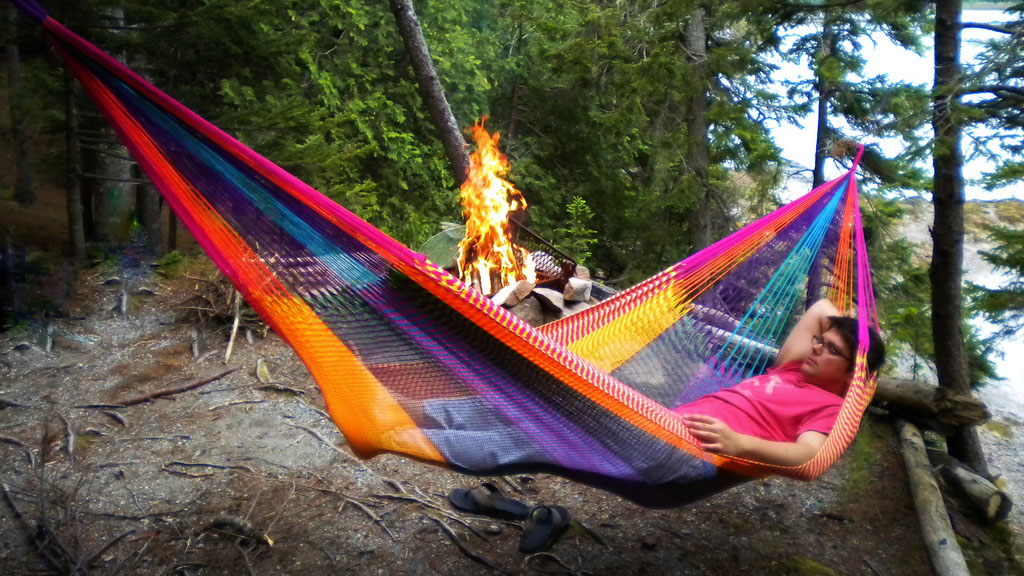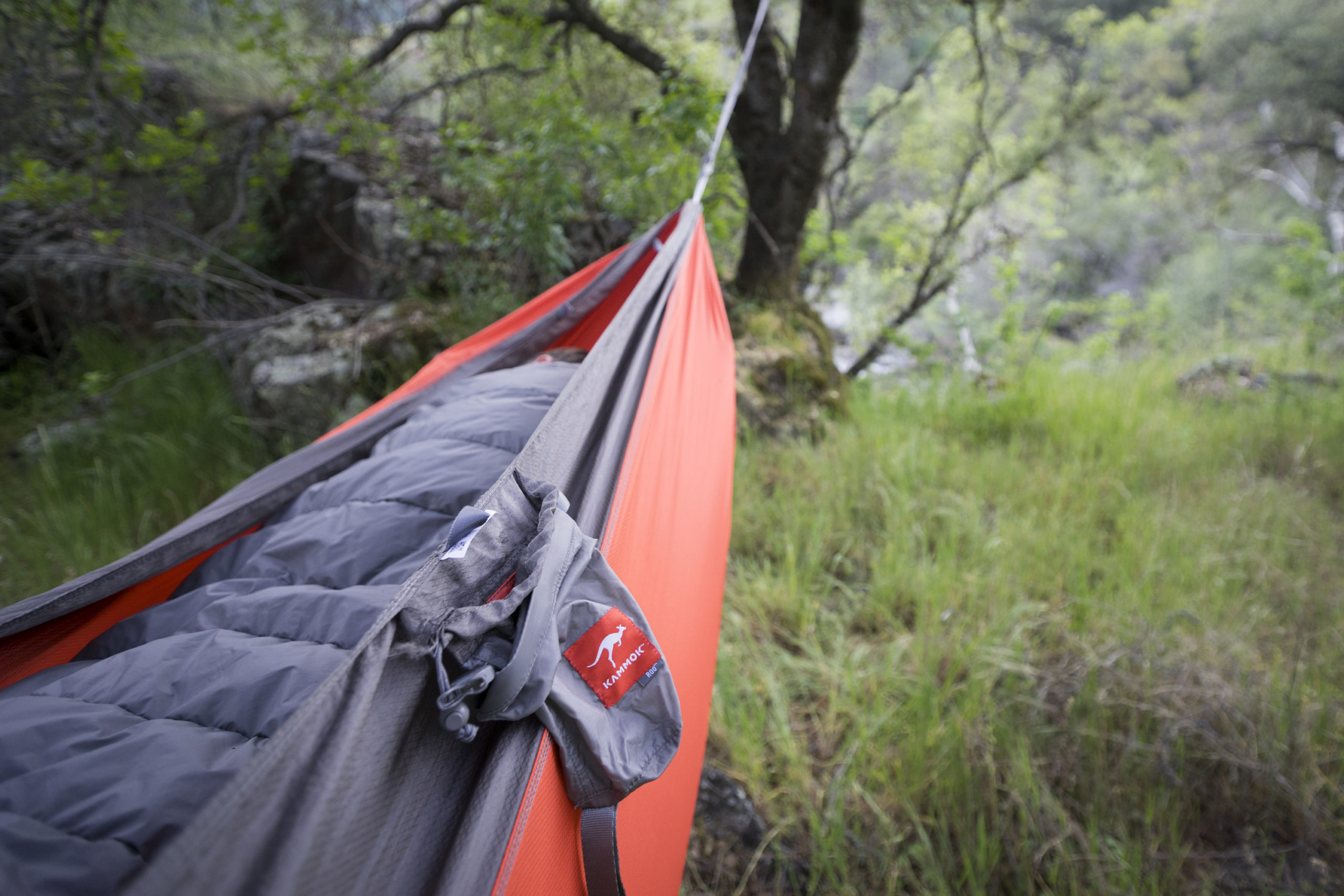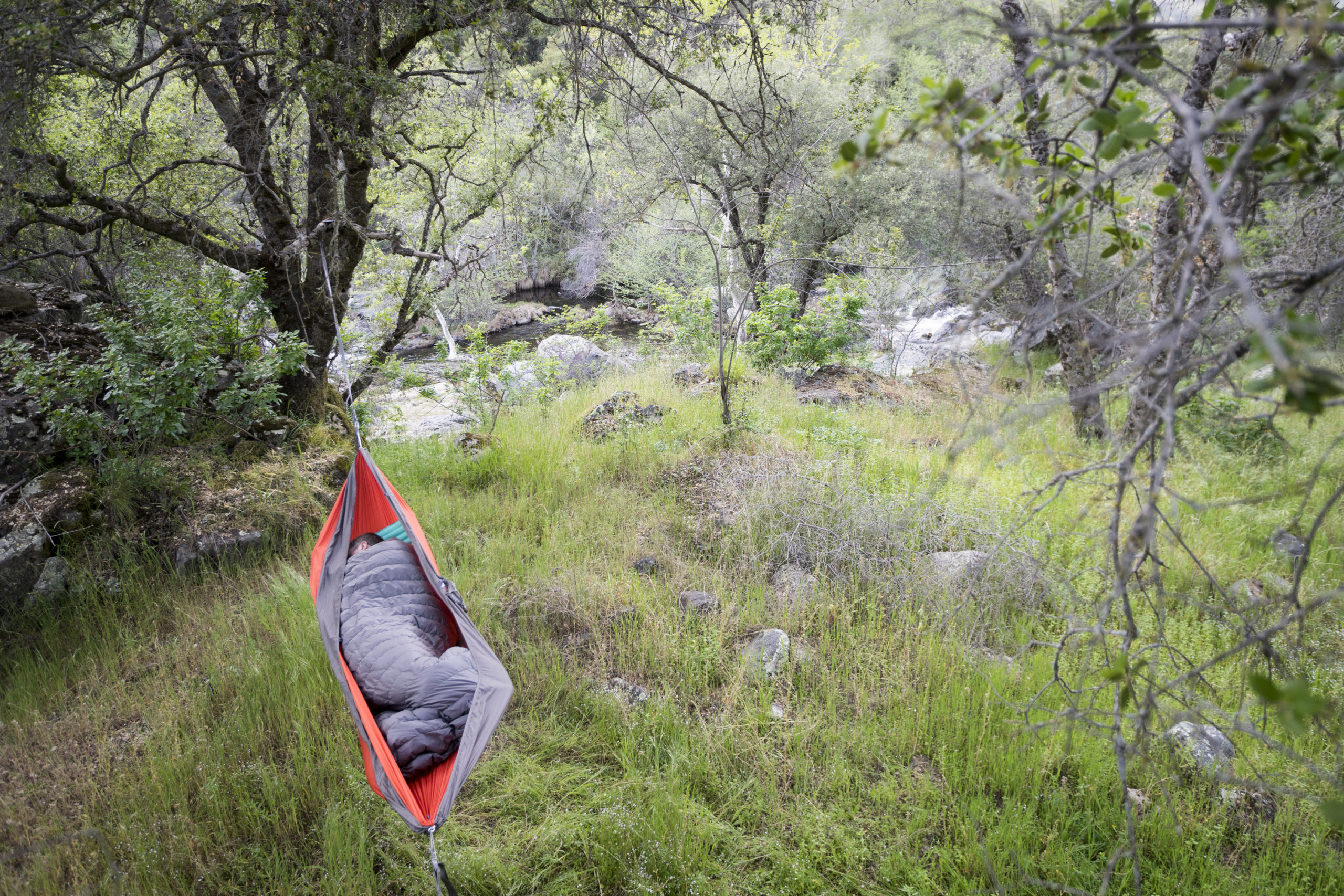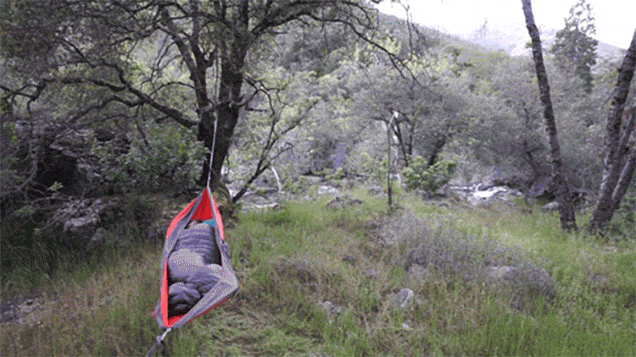I’m writing this with a sore back and exhausted from not getting enough sleep over the weekend. Hammocks lure you in with the romantic appeal of above-the-ground, free swinging sleep, then pounce on you with a poorly insulated, biomechanically painful design.
Angle Matters
Yes, I know I’m laying in it wrong in these photos. Sorry, just hopped in for a quick photoshoot and forgot you’re supposed to turn your body across the hammock’s “keel” at 30 degrees. The hammock itself is also hung a little tight as pictured; I fixed both problems about 15 seconds after climbing in that night.
This weekend was the first time I’d slept in a hammock in over a decade. I used to use one back in university, but had forgotten why I stopped in the subsequent years. This weekend ended up being a painful reminder.
In a camping hammock, the idea is to hang it loose so when you lay across it at that 30-degree angle, you achieve a sleeping surface that’s as flat as possible, with even pressure across your whole body. Of course, what the hammock industry glosses over is that your head and feet are always going to be a little raised and your butt a little sunk.
That’s fine if you’re a back sleeper. As Big Hammock is quick to point out, a raised head is thought to deliver ideal circulation for your brain. Trouble arises if, like 92 per cent of the population, you’re used to sleeping in any other way.
I roll around in my sleep, alternating between both sides, my back and several variations on the fetal position. Any time I transition out of the back position, the hammock asks my body to bend in unnatural, uncomfortable ways. You can mitigate this somewhat by using a sleeping pad (you also need its insulation), sort of forcing a portion of the hammock to flatten out a little, but you still end up slightly bent in the middle, no matter what you do. My back is not a banana.
Big Hammock argues that you’ll eventually adapt to staying on your back throughout the night. But, how many of us are sleeping outdoors regularly enough to effect and enforce a change in our unconscious, sleeping behaviour?

This photo from Yellow Leaf Hammocks illustrates that ideal 30-degree angle across the hammock. Note that your butt still sags and your head is still raised.
It’s Cold Outside
This might be different aboard a pirate ship plundering its way across the Spanish Main, but most of us landlubbers in North America are heading to the mountains, beach or desert to camp. And, in those environments, it gets chilly at night, even at the height of summer. Once temperatures drop below about 21C, you’ll need insulation underneath you.
Any sleeping bag is subject to compression when you’re sleeping in it. That’s why you need an insulated sleeping pad. Sleep on the ground and you’re subject to conductive heat loss due to contact with the colder ground. Sleep in a hammock and you’re subject to convective heat loss due to airflow.
This weekend, I used my Therm-A-Rest NeoAir All Season, which has an R-value of 4.9. That’s pretty insulative and, on the ground, I’m comfortable on it down to about -12C or so. That went under me, then on top I used Kammok’s Firebelly down quilt. That’s got a -1C comfort rating, but even in temperatures that only dipped down to 9C, I slept cold. Even in a set of Icebreaker merino base layers and socks.
I probably could have avoided that if I’d also brought the Koala under quilt that’s designed to snap right onto the Kammok and fit it perfectly. But, looking at the mild weather, I just didn’t think it’d be necessary and left it at home.
There was hardly any wind this weekend, yet sleeping off the ground was appreciably colder to sleeping on it.

Needless Complication
So, in order to go camping in a hammock, you’ll need the hammock. But, you’re also going to need a bug net to avoid being eaten alive, a tarp to stay dry, straps to hang the hammock from and an under quilt to keep you warm, even in mild weather.
Kammok is a new company that hopes its level of integration between the modular components on its hammocks, along with some slick creative, will finally help that style of sleep system go mainstream. The hammock itself is a reasonable $US99. But, to use it, you also need the $US29 Python straps, $US75 Dragonfly bug net, $US230 Glider rain fly and $US329 Koala under quilt. And all that’s in addition to the sleeping pad and bag or quilt you’d need too.
Add all that up, along with the $US230 Firebelly quilt and it totals nearly $US1000, before adding a sleeping pad. It also all adds up to 3.3kg. Again, before a sleeping pad.
Let’s compare that to the all-purpose, affordable sleep system we previously recommended. A Kelty Cosmic Down 20 + an Alps Mystique 1.0 tent + a Therm-A-Rest NeoAir All Season = $US402 and 3.2kg. And with this system you’ll sleep warmer and more comfortably.
Want to go ultralight? The fancy Big Agnes Flycreek Platinum 2 tent + Q-Core SL pad + Mystic UL 15 = $US1210 and weighs just 2.2kg. Again, that sleeps warmer, and isn’t even an apple-to-apples comparison because the tent will fit two people (lowering your combined expenditure and weight) and includes the pad.
A hammock also requires a good hanging location, between two trees. Know where there’s no trees? In places you might want to camp like above the tree line, on a beach or in the desert. So, if you might occasionally want to camp in a place like that, you’ll need a tent in addition to your hammock, further upping your total spend.
Know what I did this weekend instead of spending a second night in the hammock? Slept on the ground. Doing so was warmer and more comfortable.
Know what you can’t do in a hammock? Sleep next to your girlfriend. I won’t say you can’t have sex in one, because I bet a hammock would work pretty well as a swing, but you certainly won’t be doing it in private.

There’s Nothing Wrong With Tents
The problem that hammocks are trying to solve just isn’t a problem. Tents are as light as you want them to be, sleeping in them is immensely comfortable, provided you have a nice sleeping pad, and they’re affordable, easy-to-use and work anywhere. They can also fit two or more people, all of whom can have sex with each other if they want, and do so in private. The weather protection a good tent offers is going to be inherently superior to a hammock in severe weather. And, best of all, you likely already have a tent in your garage/attic/shed!
A hammock may work great in your yard, as a place to relax and drink a cold beer on a hot day, but as a tool for camping, they’re just too specific in their use and too uncomfortable to make any sense. Sorry, but losing a night’s sleep and dealing with a sore back all weekend just doesn’t leave me in the mood to deliver anything but that stone cold truth. Life is too short for bad camping equipment.
Pictures: Corey Hass
